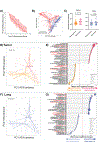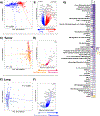Lung Microbial and Host Genomic Signatures as Predictors of Prognosis in Early-Stage Adenocarcinoma
- PMID: 39225784
- PMCID: PMC11530314
- DOI: 10.1158/1055-9965.EPI-24-0661
Lung Microbial and Host Genomic Signatures as Predictors of Prognosis in Early-Stage Adenocarcinoma
Abstract
Background: Risk of early-stage lung adenocarcinoma recurrence after surgical resection is significant, and the postrecurrence median survival is approximately 2 years. Currently, there are no commercially available biomarkers that predict recurrence. In this study, we investigated whether microbial and host genomic signatures in the lung can predict recurrence.
Methods: In 91 patients with early-stage (stage IA/IB) lung adenocarcinoma with extensive follow-up, we used 16s rRNA gene sequencing and host RNA sequencing to map the microbial and host transcriptomic landscape in tumor and adjacent unaffected lung samples.
Results: Of 91 subjects, 23 had tumor recurrence over 5-year period. In tumor samples, lung adenocarcinoma recurrence was associated with enrichment in Dialister and Prevotella, whereas in unaffected lung samples, recurrence was associated with enrichment in Sphingomonas and Alloiococcus. The strengths of the associations between microbial and host genomic signatures with lung adenocarcinoma recurrence were greater in adjacent unaffected lung samples than in the primary tumor. Among microbial-host features in the unaffected lung samples associated with recurrence, enrichment in Stenotrophomonas geniculata and Chryseobacterium was positively correlated with upregulation of IL2, IL3, IL17, EGFR, and HIF1 signaling pathways among the host transcriptome. In tumor samples, enrichment in Veillonellaceae (Dialister), Ruminococcaceae, Haemophilus influenzae, and Neisseria was positively correlated with upregulation of IL1, IL6, IL17, IFN, and tryptophan metabolism pathways.
Conclusions: Overall, modeling suggested that a combined microbial/transcriptome approach using unaffected lung samples had the best biomarker performance (AUC = 0.83).
Impact: This study suggests that lung adenocarcinoma recurrence is associated with distinct pathophysiologic mechanisms of microbial-host interactions in the unaffected lung rather than those present in the resected tumor.
©2024 American Association for Cancer Research.
Conflict of interest statement
The authors declare no potential conflicts of interest.
Figures




References
-
- Detterbeck FC, Boffa DJ, Kim AW, Tanoue LT. The Eighth Edition Lung Cancer Stage Classification. Chest 2017;151:193–203 - PubMed
-
- Detterbeck FC, Chansky K, Groome P, Bolejack V, Crowley J, Shemanski L, et al. The IASLC Lung Cancer Staging Project: Methodology and Validation Used in the Development of Proposals for Revision of the Stage Classification of NSCLC in the Forthcoming (Eighth) Edition of the TNM Classification of Lung Cancer. J Thorac Oncol 2016;11:1433–46 - PubMed
-
- van den Berg LL, Klinkenberg TJ, Groen HJM, Widder J. Patterns of Recurrence and Survival after Surgery or Stereotactic Radiotherapy for Early Stage NSCLC. J Thorac Oncol 2015;10:826–31 - PubMed
-
- al-Kattan K, Sepsas E, Fountain SW, Townsend ER. Disease recurrence after resection for stage I lung cancer. Eur J Cardiothorac Surg 1997;12:380–4 - PubMed
-
- Martini N, Bains MS, Burt ME, Zakowski MF, McCormack P, Rusch VW, et al. Incidence of local recurrence and second primary tumors in resected stage I lung cancer. J Thorac Cardiovasc Surg 1995;109:120–9 - PubMed
MeSH terms
Substances
Grants and funding
LinkOut - more resources
Full Text Sources
Medical
Research Materials
Miscellaneous

